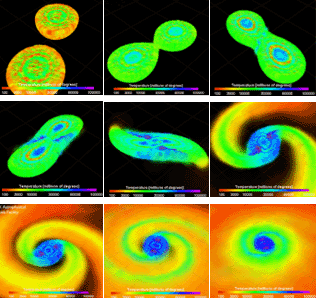Where does the gold in wedding rings come from? New computer
simulations support the theory that such heavy metals are
produced in a violent collision between two superdense neutron
stars.
 |
Gold mine. Colliding neutron stars may create
precious metals.
CREDIT: STEPHAN ROSSWOG AND RICHARD
WEST, UNIVERSITY OF LEICESTER |
Most elements in the universe heavier than hydrogen and
helium are produced by nuclear fusion inside stars. But the
heavy metals like gold and platinum are not synthesized during
a normal star's lifetime. Instead, astronomers believe, heavy
elements form by rapidly adding neutrons to existing
lower-mass atoms like iron. This can only happen in exotic
circumstances, where temperatures and densities are extremely
high. These conditions exist during a supernova, the explosion
of a massive star that has spent its fuel.
Another possible occasion is the collision of two neutron
stars, the collapsed remnants of supernovae. When two neutron
stars tightly orbit each other, they slowly spiral inward, and
a merger is unavoidable. But the theory that heavy metals came
from merging neutron stars had never been put to the test of
exhaustive computer simulations.
Using a new supercomputer at the United Kingdom
Astrophysical Fluids Facility, physicist Stephen Rosswog of
the University of Leicester, together with colleagues from
Leicester and Basel University in Switzerland, simulated the
catastrophic impact of two neutron stars. Although the
superdense stars eventually merge into a single black hole,
some debris is ejected. In this extremely dense and hot
matter, energetic neutrons can turn base elements into
precious metals, according to the simulations. The
simulations, presented on 5 April at the U.K. National
Astronomy Meeting in Cambridge, match the observed abundances
of gold and platinum in the universe.
These are the first detailed computer simulations to test
the neutron star theory. But, says Craig Wheeler of the
University of Texas, Austin, there are alternative models.
"The general belief is that [rapid neutron capture] takes
place somehow in supernova explosions. That has been hard to
prove or rule out."
--GOVERT SCHILLING
Related sites
More
images and movies from the computer simulation
UK Astrophysical Fluids
Facility
Alan
Calder's page on neutron star mergers
Primer
on the origin of heavy elements